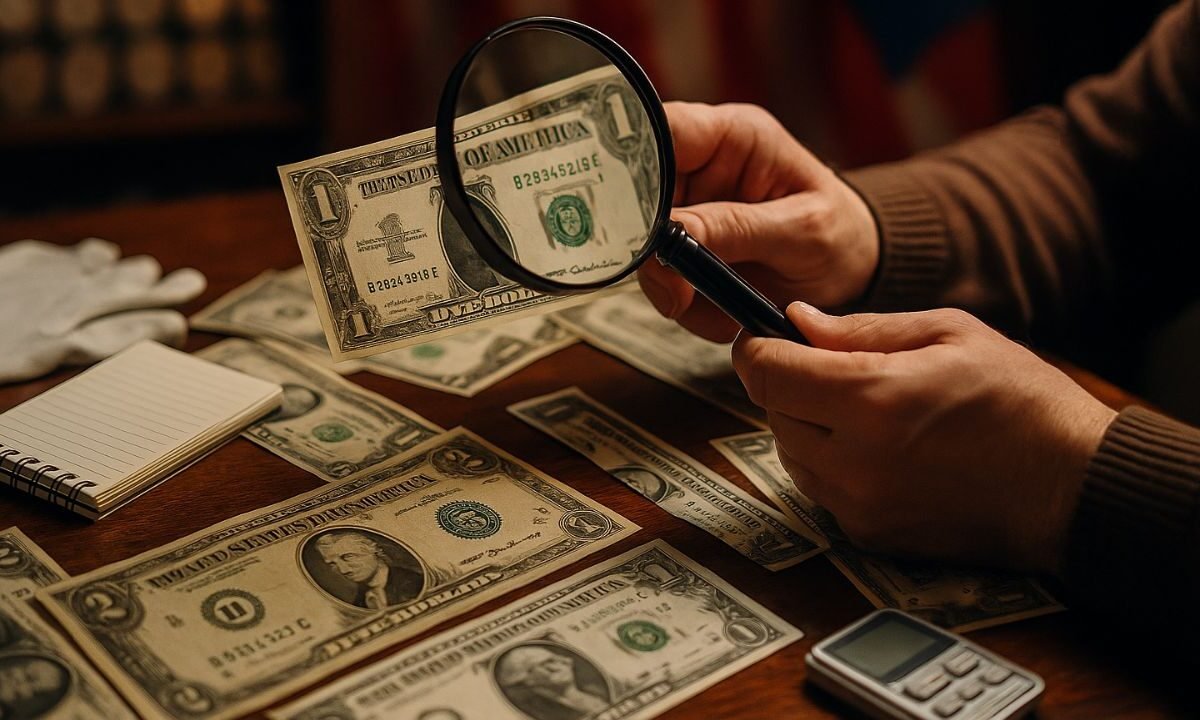Want to know if that $1 or $2 bill in your wallet could be worth far more than face value? In 2025, collectors are paying premiums for fancy serial numbers, star notes, specific printing anomalies like mules and web notes, and headline-grabbing errors such as the 2013B duplicated-serial $1 star notes.
This clear, step-by-step guide shows exactly what to look for, how to verify, and what affects today’s market value.
What Makes A Bill “Rare” In 2025
- Fancy serial numbers (for example: radar, ladder, repeater, solid, binary, or low numbers like 00000025) bring strong premiums—especially in crisp, uncirculated grades.
- Star notes (a star replacing the last letter) signal replacement prints in limited runs; smaller print runs tend to be scarcer.
- Printing varieties & errors:
- Web notes (on certain older $1 bills) printed on a continuous paper web—identified by specific layout traits—have collector interest.
- Mule notes (mismatched plate/back combinations) and dramatic error notes (inverted overprints, missing print layers, misalignments) can command big premiums.
- Headline error of the decade: Series 2013B $1 star notes with duplicated serial numbers (in certain printings) have become major collector buzz. Confirmed matched pairs have sold from hundreds to five-figures depending on condition and demand.
Quick Identification Checklist
- Check the serial number: Look for patterned or low serial numbers (for example, radar, ladder, repeater).
- Look for a star (★) at the end of the serial — if present, research the star-note run size for that series.
- Scan for web-press tells (on older $1 bills) if you’re inspecting for “web note” variety.
- Inspect for print errors: shifted seals, missing print layers, plate mismatches (mules), or dramatic misprints.
- Assess condition: Crisp, uncirculated notes multiply value; heavy wear cuts it quickly.
Fast Reference (Keep This Handy)
| Rare Feature | How To Spot It | 2025 Market Notes* |
|---|---|---|
| Fancy Serial | Patterned or very low serial number | Uncirculated examples can reach hundreds to four-figures, depending on pattern and grade. |
| Star Note (★) | A star symbol replaces the suffix letter | Smaller print runs are scarcer; check the run size to gauge rarity. |
| Web Note (1988A–1995 $1) | Web-printed layout traits on older $1 bills | Collected as a distinct production variety; values depend on block and grade. |
| Mule Note | Mismatched plate/back numbers or unexpected layout | Recognized variety; premiums vary widely depending on series and condition. |
| 2013B Duplicate ★ Error | Specific $1 star note with duplicate serial numbers | Matched pairs have realized hundreds to five-figures as of 2025. |
*Market observations are ranges based on public guides and collector trends; exact value depends on grade, demand, and specifics.
How To Verify Authenticity And Rarity
- Grade first: Keep the note in a protective sleeve; avoid folding/handling. Third-party grading services can substantiate condition and errors that drive premiums in 2025.
- Confirm star-note run size: Use up-to-date references to see whether your star note is from a scarce print run.
- Check web/mule diagnostics: Compare plate positions and layout cues against known identifiers for web notes and mule notes.
- For the 2013B duplicates: Validate series, facility codes, district, and whether the pair is verified by collector tracking forums as a matched duplicate.
Common Pitfalls To Avoid
- Assuming any star note is rare: Many star notes from commonly printed series are not scarce; the run size and condition are key.
- Overvaluing heavily circulated fancy serials: While sharp pattern serials matter, severe wear can dramatically reduce premiums.
- Misreading web/mule traits: Without accurate reference to plate layouts and printing runs you might misidentify a common note as rare.
In 2025, the fastest way to spot a valuable dollar bill is to focus on serial number patterns, verify star-note run size, and learn the telltale diagnostics for web notes, mules, and key error notes like the 2013B duplicate-serial star notes.
Combine accurate identification with high grade preservation, and you’ll maximize your chances of turning ordinary cash into extraordinary collectibles.
FAQs
Which denominations are most realistic for beginners?
Start with $1 and $2 bills—they’re cheaper to acquire, widely collected, and include many popular fakcy serials, star notes, and web/mule varieties.
Are star notes always worth more?
Not always. Value depends on the print run size of that star note’s series, condition, and demand. A very common star may bring only a modest premium, whereas a rare star in uncirculated grade could command significantly more.
What’s the big error everyone talks about in 2025?
The big headline error is the series 2013B $1 star notes with duplicated serial numbers. Verified matched pairs have become highly desirable and reached high four- to five-figure sales in strong grades.

